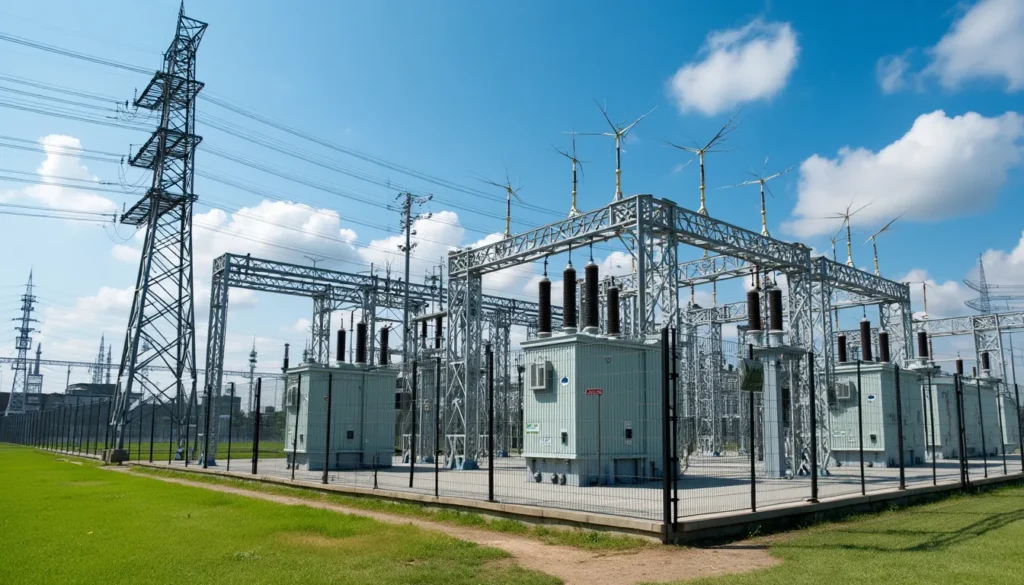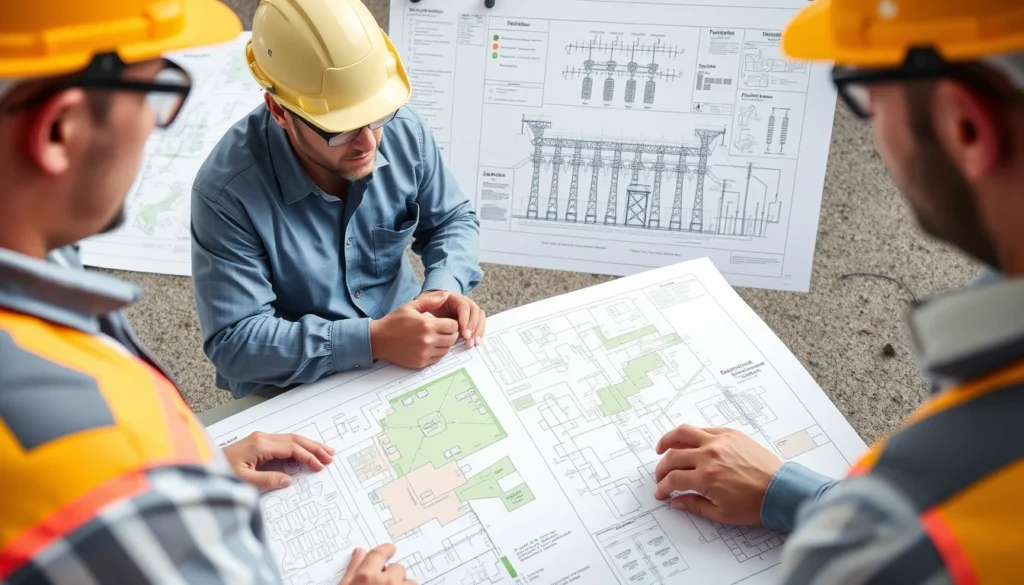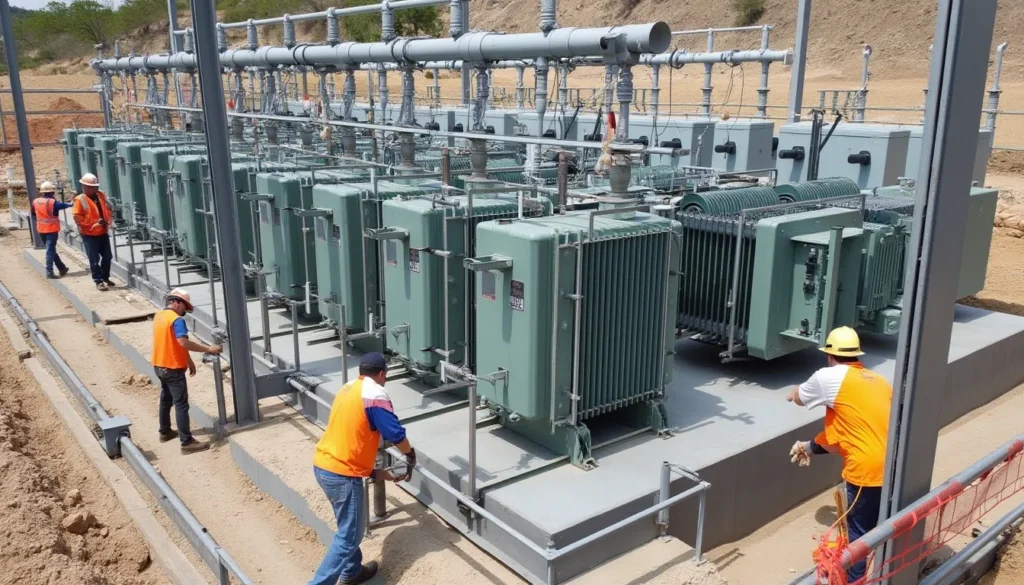Substation planning is a critical aspect of ensuring reliable, efficient, and safe electrical power distribution. Whether you are involved in the design, construction, or operation of substations, understanding the key elements of planning is essential.
What follows is a general overview of the substation planning process and introduces key topics that will be explored in greater detail in upcoming posts that will walk you through everything from site selection and design to environmental impact and regulatory compliance.
What are Electrical Substations?

Let’s start with some basics. Electrical substations are the backbone of power distribution networks, playing a crucial role in controlling and protecting the flow of electricity from generation to end users. Substations perform several key functions, including voltage transformation, switching, and fault isolation.
- Purpose: Substations are critical components that manage the flow of electricity and ensure the stability of power distribution networks.
- Key Functions: Substations step up or step down voltage levels, switch electrical circuits, and provide protection against faults.
Stay tuned for an in-depth post on electrical substations and their functions.
Types of Substations
Different types of substations serve various roles within the power system, including transmission, distribution, and generation. Each type has its unique design considerations and operational requirements.
- Transmission Substations: Handle the transmission of high-voltage electricity over long distances, connecting power generation to distribution networks.
- Distribution Substations: Reduce voltage levels for safe distribution to residential, commercial, and industrial consumers.
- Generation Substations: Located at power generation sites, these substations step up voltage for transmission.
- Switching Substations: Facilitate the routing of electricity and isolate faults within the grid.
Stay tuned for a detailed discussion on the different types of substations.
The Importance of Substation Planning
Effective substation planning ensures that the infrastructure is capable of meeting current and future electricity demands while minimizing costs and ensuring safety. Proper planning helps to avoid costly redesigns and ensures that the substation operates efficiently for its entire lifespan.
- Ensuring Reliability and Efficiency: Planning helps in designing substations that maintain a reliable power supply and optimize energy efficiency.
- Supporting Grid Expansion and Upgrades: As electricity demands grow, well-planned substations can adapt to increased loads and new technologies.
- Cost Management and Budget Optimization: Thorough planning helps in estimating costs accurately and budgeting for contingencies.
Stay tuned for a detailed post on the importance of substation planning.
Substation Planning Considerations

When planning a substation, several factors must be considered to ensure optimal performance and longevity. These include site selection, engineering design, and cost estimation.
- Site Selection Factors: The location of a substation is crucial. Factors like proximity to load centers, environmental conditions, and accessibility must be carefully evaluated.
- Engineering and Design Considerations:
- Electrical Design: This involves assessing load demand, performing short-circuit and load flow studies, and ensuring adequate protection and control systems.
- Civil and Structural Design: The substation’s structural integrity depends on geotechnical analysis, drainage planning, and compliance with seismic standards.
- Mechanical Considerations: HVAC systems, fire protection, and grounding systems are critical for safe and reliable substation operation.
- Cost Management and Budget Optimization: Thorough planning helps in estimating costs accurately and budgeting for contingencies.
Stay tuned for an in-depth post on substation planning considerations.
Environmental and Regulatory Considerations for Substations
Substations must comply with environmental regulations and obtain the necessary permits before construction. Understanding the environmental impact and navigating regulatory requirements are essential steps in the planning process.
- Environmental Impact Assessment (EIA): Assessing the environmental impact is crucial to minimize negative effects on the surrounding ecosystem and communities.
- Regulatory Compliance: Securing the required permits and approvals ensures that the substation meets all legal standards, avoiding delays and fines.
Stay tuned for a detailed post on environmental and regulatory considerations for substations.
Substation Design and Equipment Selection
Choosing the right equipment and designing the substation layout are critical for its functionality and safety. This includes selecting transformers, switchgear, and other essential components.
- Typical Equipment in Substations: The selection of transformers, circuit breakers, busbars, and other equipment must be tailored to the specific needs of the substation.
- Air-Insulated vs. Gas-Insulated Substations: Each type of substation has its advantages and drawbacks, depending on factors like space constraints and environmental conditions.
- Substation Layouts and Configuration: The physical layout and configuration of the substation affect its efficiency, reliability, and ease of maintenance.
Stay tuned for a comprehensive post on substation design and equipment selection.
Substation Construction and Implementation

Once the planning and design phases are complete, the substation moves into the construction and implementation stage. Effective project management, quality control, and safety measures are key to successful construction.
- Phases of Substation Construction: The construction process is divided into distinct phases, from site preparation to commissioning.
- Project Management Best Practices: Effective management ensures the project stays on schedule and within budget, while addressing any challenges that arise.
- Quality Assurance and Safety Protocols: Rigorous testing, commissioning, and adherence to safety standards are crucial to ensure the substation operates safely and efficiently.
Stay tuned for a post on substation construction and implementation.
Conclusion
Substation planning is a multifaceted process that requires meticulous attention to detail, from understanding the core functions of electrical substations to selecting the right equipment and ensuring regulatory compliance. Proper planning lays the foundation for substations to efficiently manage the flow of electricity, whether for transmission, distribution, generation, or switching. By considering critical factors such as site selection, load demand, and environmental impact, planners can design substations that are not only reliable and cost-effective but also adaptable to future energy needs.
A well-planned substation supports grid expansion, optimizes energy efficiency, and reduces the risk of costly redesigns or operational failures. Moreover, addressing environmental and regulatory requirements ensures that the substation operates within legal standards, minimizing delays and potential fines. As you continue through this series, each post will dive deeper into these topics, offering you the tools and insights needed to plan and execute a successful substation project. Stay tuned for more expert insights and detailed guidance!



